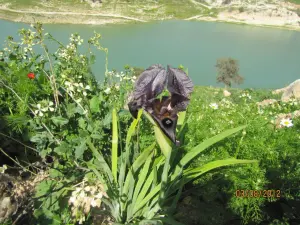
When thinking of flowers the first thing that comes in mind is its bright, striking colors. However, the national flower of Jordan is the jet-black Iris. Blooming in spring, this delicate flower can be seen near all of Jordan’s cities during its short season. Still, the flower grows in abundance in particular on village roads in the Karak terrain, between Karak and Wadi Mujib. The black iris quietly spreads throughout the Ghor EcoPark area during the spring, as well. A tourist wishing to see and identify the ten types of black irises in Jordan can do so through visiting the Sharhabil bin Hassaneh EcoPark (SHE) in the north and purchasing the SHE wildflower guide.
To the south of Amman, you can find the real Black Iris ‘Iris nigricans,’ which looks like it was dipped in pure black ink and has an eye catching luster. A favorite species of mine is the German Iris ‘Iris germanica’ which is said to be found almost exclusively in ruins and graveyards. It can grow up to 80 cm, with blue-violet flowers on branching stalks.

Nine types of iris grow in Jordan. There used to be ten distinct species, but due to human irresponsibility, one kind of the Iris family is now extinct, the once exquisite “Iris vartanii.” For, as beautiful as these flowers are, they are becoming rarer in Jordan due to human interactions. People should not pick a wild iris, as it is considered to be an endangered plant, and its root system is close to the surface, meaning that if you pick one flower you could easily uproot the entire root complex. A Black Iris won’t thrive in house-gardens, due to difference in environment and soil conditions.
Ignorance and carelessness are the main rivals to a sustainable co-existence between the endangered Iris population and human development in Jordan. In order to maintain the existence of the the nine types of iris, a reserve where they are protected should be created. Currently FoEME’s SHE EcoPark serves to preserve nature surrounding the Ziglab Dam including the black Iris which can be seen from SHE walking trails in spring. The destruction of the iris habitat has made it quite vulnerable to extinction. If we do not act now, Jordan will slowly, but assuredly, lose the overlooked Iris, its national flower.
This post was written by FoEME student intern Bader Al-afghani. Bader is 16 years old, and currently attends the Amman Academy.